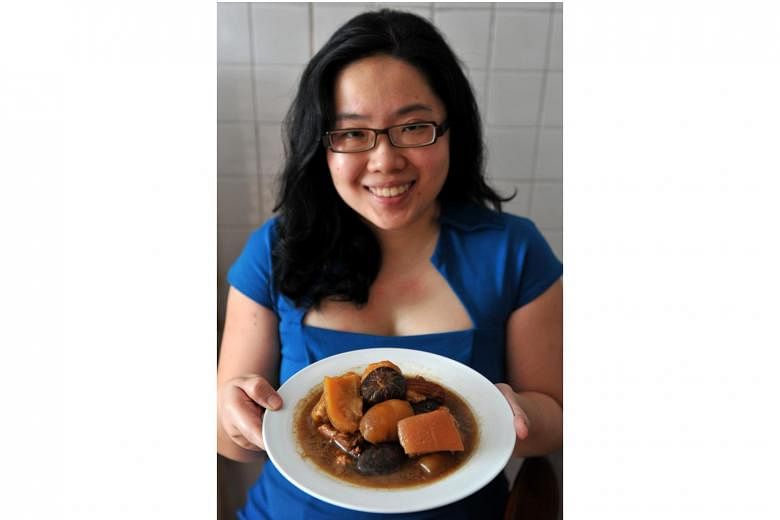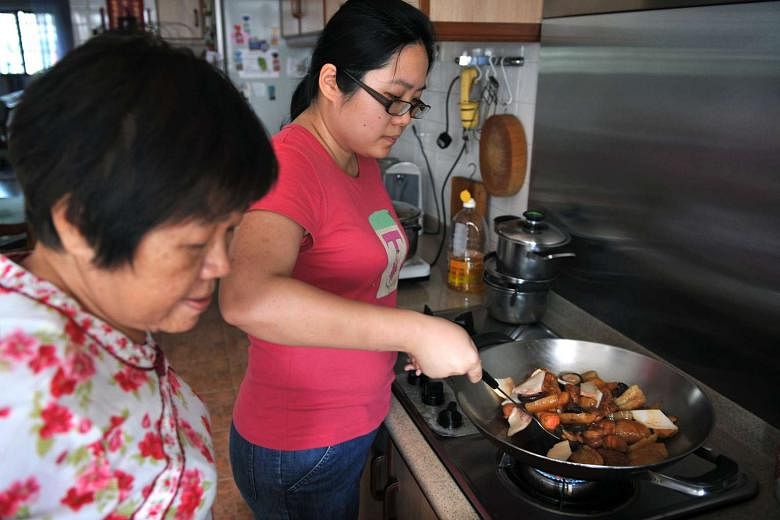This story was first published in The Sunday Times on Jan 15, 2012.
For a few years now, we have been concerned about our ageing heroine.
As the Chinese New Year marathon looms, we wonder: Can she do it this year, and do we want her to?
We are a traditional Cantonese-Hakka family who take food, festivals and therefore festive feasting seriously, you see, and my mother is a tremendously devoted housewife with a strong track record.
-
THE FOONG FAMILY'S HAKKA-STYLE BRAISED SEA CUCUMBER
-
INGREDIENTS
2 dried sea cucumbers, about 150g in total
600g pork (inner thigh of pig's rear leg or foreleg, with skin)
10 dried mushrooms, rinsed and soaked overnight
2 slices dried conch or 2 small dried squids, rinsed and soaked overnight (retain the water)
1 Tbs oil
2 5cm-long ginger stems, peeled, halved and smashed
1 Tbs yellow rice wine, or Huadiao wine or Martini Rosso vermouth
Ingredients for marinade:
1 tsp light soya sauce
1 tsp dark soya sauce
½ tsp sugar
½ tsp salt
1 tsp yellow rice wine, or Huadiao wine or Martini Rosso vermouth
Ingredients for braising liquid:
About 2 Tbs oil
½ tsp sugar
1 Tbs yellow rice wine, or Huadiao wine or Martini Rosso vermouth
Several bowls of waters -
METHOD
1. Submerge sea cucumbers in a large pot of water. Cover, bring to a boil and turn off the heat. Remove the cover and let the sea cucumbers remain in the water overnight. When soaking sea cucumbers, always keep them away from oil or they will smell.
2. Repeat step 1 for a few days, changing the water every day. By the third or fourth morning, the sea cucumbers should have softened. Cut them open to remove the waste and insides. It will be difficult to remove everything in one morning.
Try again, after changing the water, boiling it, and letting the sea cucumbers cool in it for another day. Repeat, till the insides are all removed.
You can store the clean sea cucumbers in the freezer, till you need them. Bag them up with a bit of water so they will not stick to one another when they freeze and you will not tear them when you thaw them.
3. Rinse pork, and cut it into chunks. Place it in a bowl, add light soya sauce, dark soya sauce, sugar, salt and yellow rice wine and marinate it for 20 minutes. Cut the sea cucumbers into chunks. Cut conch into strips.
4. To a large wok on high heat, add oil. Add half the ginger and fry till fragrant. Add the sea cucumber, fry till fragrant. Add yellow rice wine. Add enough water to cover the sea cucumber.
Let it boil for two to three minutes. Discard the water and ginger. Rinse the sea cucumber in cold water and drain it. Set it aside.
5. To the wok on high heat, add 1 tsp oil. Add mushrooms and sugar, fry till the sugar melts. Set aside.
6. To the wok on high heat, add 1½ Tbs oil. Add the other half of the ginger, fry till fragrant.
Add the pork, fry till fragrant. Add the sea cucumber, drizzle yellow rice wine down the sides of the wok, fry till fragrant. Add the mushrooms and conch, fry till fragrant. Add the water the conch was soaked in.
7. Transfer everything to a large pot. Add enough water to cover the sea cucumber. Cover, bring to a boil, and cook on low heat for about two hours. Discard the ginger before serving.
Serves 10.
Note: More light soya sauce or salt may be added to taste.
Every Chinese New Year, she cooks a series of major meals spread across 16 days, starting with the reunion dinner on New Year's Eve - as many as 10 dishes for nine or more family members - which she begins preparing about a month before, while baking pineapple tarts and cashew cookies in between.
Short of roasting a pig herself (it is not beyond her, strictly speaking, but it is beyond our oven), she cooks for the reunion dinner a long list of dishes including pig stomach's soup, poached (or drunken) chicken, sweet-and-sour prawns, braised mushrooms, braised oysters and braised sea cucumber. (The roast pork, the one and only dish she doesn't make, she warms in the wok to make it even cracklier.)
Then, when New Year dawns the next day, she wakes up to make a red fermented bean curd and vegetable stew, a Cantonese vegetarian classic we start the year with.
For decades, she had been our iron woman. But as she neared her 60s a few years ago, we began to worry about her stamina.
We tried to talk her out of braising sea cucumber, a labour-intensive Hakka dish so rich that it tends to be untouched on a night of heavy eating. Heaps of work - including a week or so of soaking sea cucumber and washing it - and nobody eats it. To which she would say: "No, but so-and-so eats it."
No, we can't beat her and so, little by little, we have been joining her. One of my two brothers convinced her to outsource the braised mushrooms to his kitchen after he married and moved out more than two years ago. (He takes it as seriously as she does, and makes his own chicken stock to cook the mushrooms in.)
Last year, my other brother learnt to make the vegetable stew.
And even I, ever the laggard, am learning to braise sea cucumber this year.
My mother is the proverbial hardworking Hakka woman and my father, a fastidious, traditional Cantonese man. It follows that she's the cook in this marriage and he's the tough customer, or the critic.
He is also something of a curator, who always asks rhetorically when he likes a new dish: "What shall we name this?" I always understand this to be his way of saying, "This is good and I expect to eat it again."
I think it is how braised sea cucumber, a dish from my mother's childhood, entered the family canon.
When I ask her about it, she says with some pride: "I taught your dad to eat it. He grew up eating only the things his grandma cooked, and I taught him to eat other things."
For years, I have been more of my father's daughter, content to sit at the dinner table and give jokey grades to her cooking.
So I am no cook, not at all, but I have found it easy to follow my mother's instructions and braise sea cucumber. After all, the real work was done by her through the years, as she refined her recipe through trial and error.
A self-taught cook, she hydrates and washes the dried sea slugs herself because the commercially available ones, she suspects, have been enlarged beyond their natural size with a chemical solution and tend to melt away when they are cooked.
It can take five days or longer to clean them - as long as it takes for the waste and filaments inside them to loosen and be removed gently.
Once the sea cucumber has been cleaned and stir-fried with ginger and wine to remove any fishy smell, it's a cinch to cook, however.
Marinate pork. Stir-fry mushrooms. Stir-fry pork. Place sea cucumber, pork, mushrooms and conch into pot and braise for two hours. After five days of cleaning sea cucumber, two hours is hardly anything.
And when my family try it, they finish it in no time at all - with my parents sharing the very last piece.



